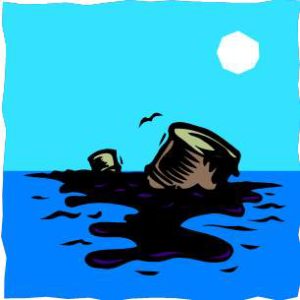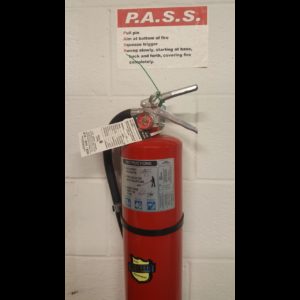Federal regulations of the U.S. Environmental Protection Agency (USEPA) require a small quantity generator of hazardous waste (SQG) to maintain equipment and processes to prevent a hazardous waste emergency and to respond to it if one occurs. The regulations are found in the following SQG conditions for exemption:
- 40 CFR 262.16(b)(8) Preparedness and prevention
- 40 CFR 262.16(b)(9) Emergency procedures
This article is the tenth – and final – in a series that closely examines and explains these regulations.
In the previous article in this series I addressed the requirements of 40 CFR 262.16(b)(9)(iii) Ensure Familiarity with Emergency Procedures at a Small Quantity Generator. That was the third of the Emergency Procedures requirements of §262.16(b)(9). This article addresses the fourth and final.
The purpose of this article is to identify and explain: 40 CFR 262.16(b)(9)(iv) Ensure familiarity with emergency procedures at small quantity generator of hazardous waste.
Before we begin…
These regulations were revised by the Generator Improvements Rule. If your state has not yet adopted the new rule you must continue to comply with the earlier version until it does. You may read an article explaining the earlier version of the regulations (prior to implementation of the Generator Improvements Rule) here. Later in this article the changes made by the Generator Improvements Rule will be addressed.
After your state adopts the Generator Improvements Rule, it may choose to make its version of these regulations more stringent and more broad than these Federal regulations. The actions of your state will vary based on whether or not it has an authorized hazardous waste program. Be sure to check the regulations of your state to ensure compliance.
Scope and applicability:
The regulations addressed in this article are applicable to a SQG. A large quantity generator of hazardous waste (LQG) has its own distinct requirements for Preparedness, Prevention, and Emergency Procedures. Also, the emergency response requirements for a LQG are more broad and stringent than those of the SQG.
|
Not sure of your hazardous waste generator category? |
The placement of these regulations squarely within 40 CFR 262.16 Conditions for exemption for a small quantity generator that accumulates hazardous waste removes any doubt that these regulations apply solely to a SQG.
But where at a SQG? The entire facility? And what operations? Just those related to hazardous waste management? In the preamble to the final rule in the Federal Register, USEPA stated its primary objective was to ensure these regulations do not apply to the entire facility (November 28, 2016, FR 81, 85792). However, USEPA did clarify that these regulations – and all preparedness, prevention, and emergency response procedures of both SQG and LQG – are applicable to all areas of a facility where hazardous waste is:
- Generated. This means all points of generation.
- Accumulated. This includes both central accumulation area(s) (CAA) and satellite accumulation area(s) (SAA).
- Those areas where allowable treatment of hazardous waste may occur in accumulation units (November 28, 2016, FR 81, 85792).
All satellite accumulation areas operated by a small quantity generator must meet the preparedness and prevention regulations of §262.16(b)(8) and emergency procedures of §262.16(b)(9). Prior to the Generator Improvements Rule agency guidance and enforcement limited the applicability of these regulations solely to hazardous waste in the CAA and did not include the SAA. To clarify its position in the preamble, USEPA also added the following to the revised regulations for SAAs at §262.15(a)(7):
All satellite accumulation areas operated by a small quantity generator must meet the preparedness and prevention regulations of §262.16(b)(8) and emergency procedures of §262.16(b)(9).
This is further reinforced by the opening paragraph of §262.16(b)(9), which reads:
The small quantity generator complies with the following conditions for those areas of the generator facility where hazardous waste is generated and accumulated:
|
Like this article? Subscribe to my Monthly Newsletter No marketing emails! |
40 CFR 262.16(b)(9)(iv) reads:
The emergency coordinator or his designee must respond to any emergencies that arise. The applicable responses are as follows:
(A) In the event of a fire, call the fire department or attempt to extinguish it using a fire extinguisher;
(B) In the event of a spill, the small quantity generator is responsible for containing the flow of hazardous waste to the extent possible, and as soon as is practicable, cleaning up the hazardous waste and any contaminated materials or soil. Such containment and cleanup can be conducted either by the small quantity generator or by a contractor on behalf of the small quantity generator;
(C) In the event of a fire, explosion, or other release that could threaten human health outside the facility or when the small quantity generator has knowledge that a spill has reached surface water, the small quantity generator must immediately notify the National Response Center (using their 24-hour toll free number 800/424-8802). The report must include the following information:
(1) The name, address, and U.S. EPA identification number of the small quantity generator;
(2) Date, time, and type of incident (e.g., spill or fire);
(3) Quantity and type of hazardous waste involved in the incident;
(4) Extent of injuries, if any; and
(5) Estimated quantity and disposition of recovered materials, if any.
Why the change?
The big change to these regulations from the Generator Improvements Rule is now the containment and clean-up after a spill may be performed by a contractor working for the SQG. This will be discussed in more detail later in this article.
|
Interested in site specific training at your site that covers this topic, and more! Ask me about my Onsite Training |
What’s the Point?
USEPA’s purpose was to ensure the SQG will respond properly to emergencies (fire, spill, explosion, or release to the environment) that may occur as a result of its hazardous waste management.
“The emergency coordinator or his designee…”
§262.16(b)(9)(i) mandates the SQG have at least one emergency coordinator on-site or on-call at all times (read: SQG Emergency Coordinator). It goes on to state the emergency coordinator is the person responsible for coordinating all emergency response measures at the SQG.
The opening statement of this paragraph makes it clear that while the emergency coordinator is still the person in charge at the SQG during an emergency, they are not the only one authorized to perform a required response. The emergency coordinator may designate someone to respond as necessary. This designee need not be an emergency coordinator themselves as long as they perform under the direction of the SQG’s emergency coordinator. Remember: if a person performs an emergency response function they are then subject to the SQG training. requirement of 262.16(b)(9)(iii).
|
Contact me with any questions you may have about the generation, identification, management, and disposal of hazardous waste Daniels Training Services, Inc. 815.821.1550 |
“…must respond to any…”
A response to an emergency by the SQG is required. The SQG must be prepared to respond to any emergency. However, the paragraph continues and identifies applicable responses to specific emergencies.
From RO 11429:
To comply with these requirements, virtually all small-quantity generators will need to plan for more than evacuation and calling the fire department.
“…applicable responses are as follows:”
In sub-paragraphs (A), (B), & (C) options for responding to specific emergencies at a SQG are detailed. Of course, the opening sentence indicates the SQG must respond to any emergency that arises, not just the three specifically identified here. However, the emergencies and their applicable responses are a good indication of USEPA’s concern for a SQG and what it expects of them. Remember, SQG training must – at a minimum – include these emergencies and the response to them.
The SQG’s compliance with earlier Preparedness, Prevention, and Emergency Procedures will affect their compliance here. e.g., required equipment, access to communications or alarm systems, arrangements with local authorities, posting emergency response information.
|
Contact me the next time hazardous waste generator training is due to expire. |
“…fire…”
USEPA identifies two options for the SQG in the event of a fire:
- Call fire department. This is a more passive – and perhaps safer – response. In this option employees would likely be directed to get themselves and others to safety while informing appropriate personnel so they can contact the local fire department or make the call themselves.
Or…
- Attempt to extinguish it using a fire extinguisher. This requires more active participation by the emergency coordinator – or, more likely, their designee. If the SQG chooses this option it will have to provide training to personnel it authorizes to use fire extinguishers.
Though not clearly stated, I think some combination of these two options will be acceptable to USEPA.
“…spill…”
The SQG has two responsibilities – these are not options – in the event of a spill (this is not a release into the environment, that is addressed next):
- Contain the spill as much as possible.
And…
- Clean up the hazardous waste and any contaminated materials or soil as soon as practicable.
“Such containment and cleanup…”
Here is the big change to these regulations. Though implied in the original version, USEPA felt it necessary in the Generator Improvements Rule to provide clear flexibility to a SQG to allow cleanup to be performed either by its employees – who then must be trained to ensure they are thoroughly familiar with these responsibilities – or by a contractor and thus spare the SQG from providing training on an activity that may occur infrequently or not at all.
To ensure this flexibility, USEPA added clear language that both the initial containment and the cleanup may be performed by the SQG or a contractor working on behalf of the SQG. Regardless of who performs the response, the SQG is ultimately responsible for ensuring proper response and cleanup to a spill.
“…fire, explosion, or other…”
This emergency is more severe than the others. While not the only response – putting out the fire and containing the spill remains – this paragraph requires notification of the National Response Center. The conditions that necessitate a notification are as follows:
- Any of the following if it could threaten human health off the SQG’s property:
- Fire
- Explosion
- Other release
Or…
- SQG is aware a spill has reached surface water. This could include drains that connect to a surface water.

Be aware that your state, county, municipality, perhaps even your region if you operate within a sensitive watershed, may require notification in addition to the NRC. A SQG must research these notification requirements prior to the release to ensure everyone who needs to know is informed.
“…include the following information:”
The notification to NRC must include the following:
- Date, time, & type of incident (e.g., spill, fire).
- Quantity and type of hazardous waste involved in incident.
- Extent of injuries, if any.
- Estimated quantity and disposition of recovered materials, if any.
|
If you like this article, please share it using any of the social media platforms identified at the bottom of this article. You’ll look real smart recommending my articles! |
A quick Summary:
USEPA regulations do not require the SQG to have an emergency response plan or any other documented procedures to respond to emergencies. The LQG, however, must have a contingency plan along with its required emergency procedures. The SQG must respond to specific emergencies in a specified manner if they occur.
Is that it?
Yeah, actually, that’s about it. This is the final article in a series that went all the way through the responsibilities of both the LQG and the SQG to prevent, prepare, and respond to hazardous waste emergencies.
Remember, training is one way to ensure the employees of a SQG are “thoroughly familiar” with these emergency procedures and the remainder of their responsibilities under Federal and State hazardous waste regulations.

